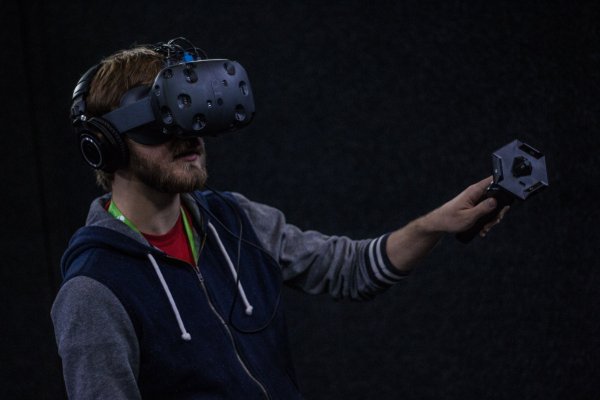Virtual reality. If you’re sick of the sound of VR already consider that a taster of the queasy sensations tech companies are aiming to flog consumers this year. To wit: HTC has just announced a second gen dev kit version of the Vive virtual reality headset it’s making in partnership with games publisher Valve.
Although unveiled back in March 2015, and originally slated for release in late 2015, Vive’s consumer release has been delayed til April 2016.
The first wave of Vive dev kit headsets shipped in June but HTC has now announced a redesigned version of the dev kit, with various tweaks aimed at improving comfort and controls for the user, as well as enhancing visual performance and image clarity (i.e. so it’s less likely to make you feel sick…)
But the most notable change to the headset is the addition of a front-facing camera allowing for a blurring of the line between VR and AR. This is interesting given that the (apparent) selling point for virtual reality is the ability to be entirely immersed into a virtual environment — suggesting total escapism is the goal. Whereas augmented reality is about blending digital content into real world environments, allowing the user to supplement a view of the real world with additional digital content or context. Seen from that perspective VR and AR are effectively at cross purposes.
However HTC-Valve appear to be aiming to cross the VR-AR streams on purpose, noting in a press release that the Vive Pre’s “newly developed front facing camera allows you to do more both inside and outside your Virtual world by blending physical elements into the virtual space”.
“Being able to take a seat, find your drink, and carry on conversations without removing your headset is only the beginning of what’s possible,” they add, as if describing real life and yet not. (Truly VR PR has to be the most surreal flavor of PR there is.)
By combining VR and AR in one mixed reality headset, HTC-Valve appear to be hoping the Vive will gain a differentiating advantage versus Facebook’s much-hyped Oculus Rift, also due to ship to consumers in early 2016, and other VR headsets-in-the-making, such as Sony’s PlayStation VR.
The Vive has another string to its bow in that it will also ship with controllers, whereas Oculus buyers will have to wait till the second half of 2016 to get their hands engaged with that flavor of VR. However Oculus’ headset will ship just before Vive. So it’s swings and roundabouts — probably queasy ones — for VR fans eager to get early adopting.
HTC-Valve say they will be kicking off 2016 by making an additional 7,000 dev units available — although there’s no word yet on when exactly the Vive Pre headset will go on sale, nor how much it will cost. The original dev kit started shipping out in very limited quantities so the pair are clearly stepping up their efforts to deliver content as the consumer release of Vive looms, as well they must.
Without compelling content, VR is basically just a person with a silly-looking appendage strapped to their head. So it’s abundantly clear that the much hyped VR ‘experiences’ we keep hearing about are going to have to be verrrrrry compelling indeed to overcome the dork factor. And the nausea. No pressure then.
